CABBAGE ~Brassica oleracea
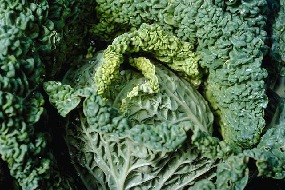
"The time has come...to talk of many things: of shoes..and ships, sealing wax...of cabbages and kings..and why the sea is boiling hot..and whether pigs have wings." ~ Lewis Carroll
Cabbage and its "digestive side effects" are often the brunt of jokes and unfortunately, a reason given for not eating it often/enough or at all. But this plant has a very rich history of healing and nutrition and even the ancient Greeks and Romans made humorous comments about the odors that emerge while cooking...and after eating. Sometimes, it is worth taking the good with the bad....cabbage is such an example.
HISTORY ~ The cabbage belongs to the big cruciferous family (brassica) and includes all the veggie favorites (of adults--but not kids) such as broccoli, brussel sprouts, kale, cauliflower, collards, kohlrabi and bok choi. Originally a weedy and loose leaf plant coming from various parts of the world, where every culture saw fit to improve the plant to the point where we now have tight heads of dense vegetable material that keeps well and offers many nutrients.
In China,cabbage stored in pots for over 6,000 years has been found, where pickling/souring seemed to be the favored preparation of what they considered to b a "cooling" food/medicine. The Roman writers, Pliny, listed cabbage in his medical text "Materia Medica" as a superior poultice herb, while Cato was fond of eating raw cabbage with vinegar. Spreading all over the world, specific dishes, such as coleslaw was probably invented by the Dutch as their words "kool" =cabbage and "sla"=salad and Colcannon, became an Irish specialty, while Germans invented sauerkraut.
The fact that it keeps, easy to prepare or easily eaten raw, recognized as bestowing various health benfits and that it grows anywhere where there is some cool weather, has made Cabbage a worldwide winner-in spite of its unflattering side effects. Today, it is estimated that the USA, alone, produces 2.5 billion pounds of cabbage per year, with California and New York leading production. It is said that the Gettysburg Address has 286 words, the Declaration of Independence, 1,322 words, but the US government's regulation of cabbage growth and sales contains 26,911 words--making it obviously important in the grand scheme of things!
MEDICINAL ~ Inexpensive, tons of vitamins and minerals, tasty, versatile and almost no calories- a perfect medicine!
Cabbage is especially high in Vits. C and K, Bs, manganese, calcium, potassium, Omega 3 fatty acids and fiber. It also has a significant amount of protein for a plant. There is also a high sulphur content that makes it a great germ killer--and is responsible for the after dinner flatulance.
The Doctrine of Signature for this plant is fairly obvious. All of the deep veining indicates its usefulness to the circulatory system and any organ that has large portions such as the entire gastrointestinal tract and lungs. All crunchy plants happen to have a good amount of usable Calcium, the strong leaf spines and stalk point to strong bones/tendons/sinews. Cut crossways, it resembles the inner structure of the breast and the fact that cabbages are referred to as "heads" shows the recognition of its likeness to and affect on the brain. Many cabbages are "wrinkled", pointing to usefulness in aging issues. It is also mostly water and does aid in kidney health and weight loss and as a detoxifier...and acts to lubricate the body to aid arthritis. Consider that water content--very high, yet cabbage presents itself outwardly as rather dry--so it is considered good for "damp" diseases--where the body is having difficulty processing liquids (excess phlegm, arthritis, watery stools, etc.) As all good detoxifing herbs do, it can rid the body of long standing and seemingly unrelated discomforts by a "peeling back" effect of various basic problems that may have, over years, led to /contributed to other illnesses--or expell effects of long standing pharmaceuticals/toxins. The Doctrine of Signature showing this in cabbage, is its layers of leaves. Fairly profound!
GENERAL HEALTH ~ Eating cabbage daily pretty much works on all body systems and builds overall immunity. It is not conducive to taking Cabbage in pill or tincture form, rather it needs to be eaten, raw or juiced in the amount of 1 cup per day. Studies have shown that 1 cup is optimal and sufficient to confer health benefits as long as the cabbage is fresh. The also found that RED cabbage and Bok Choi to be more healthful that green cabbage--by far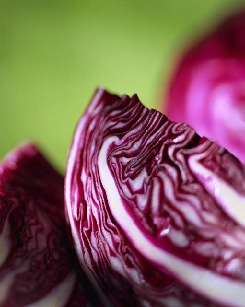 . Cooking cabbage occasionally is fine, but on a regular basis, raw is best. Cabbage was not only highly regarded as a cure all--it was also considered powerful enough to confer its benefits by proxy ! ..." Store the urine of anyone who eats cabbage, warm it, bathe the patient in it. With this treatment, you will soon restore health. It has been tested---Those who can not see clearly should bathe their eyes in this urine and they will see more". ~Cato . Cooking cabbage occasionally is fine, but on a regular basis, raw is best. Cabbage was not only highly regarded as a cure all--it was also considered powerful enough to confer its benefits by proxy ! ..." Store the urine of anyone who eats cabbage, warm it, bathe the patient in it. With this treatment, you will soon restore health. It has been tested---Those who can not see clearly should bathe their eyes in this urine and they will see more". ~Cato
Greek writer Pliny states "When the cabbage is taken raw in the mornings, together with oxymel, coriander, rue, mint and silphium root...it is good for headaches, impaired vision, spots before the eyes, for the spleen, stomach and for hypochondria". So it was seen as not only good for what ailed you--but also good for whatever you IMAGINED ailed you--now THAT is a cure all!
Sailors used to carry cabbage on long voyages to ward off scurvy, systemic and contagious infections and to provide a good source of nutrition. "Let them fart fire and brimstone... I will not have a single case of scurvy on my hands (the shame of sea surgeons) while there is cabbage to be culled". ~ Patrick O'Brian
Finally, in terms of general health, Sauerkraut is unusual in that its fermentation process allows the Vit. B levels of cabbage to rise higher than raw cabbage--and--allows us to metabolize it easily. In so doing, we can ward off nerve problems that range from depression to physical problems such as neuralgia .
Bruises/Wounds ~ Applying a poultice of the leaf (pulped by mashing it with a rolling pin) works wonders for black eyes, aches, mashed fingers, pus filled wounds. It is soothing and the sulphur content lends anti-bacterial effects... "It will purge wounds full of pus and can make them well when no other treatment can accomplish it" --and--"Fresh or old wounds or even malignant lesions that can not be otherwise healed, should be foemented with hot water and pounded cabbage twice a day"~ Cato
Eyesight ~ The water content and veining of the cabbage leaves make it seem a natural for eye ailments--especially those of old age (floaters, cloudiness, strain, dimming)--many cabbages are WRINKLED, after all!. The juice is most often used here-fresh/strained and applied to the eyes daily (just a few drops). The Greeks suggested adding the juice ot honey and dabbing it in the eye corners.
Internal Bleeding ~ There are several references to the use of cabbage in coughing up blood from the stomach (ulcers) or the lungs or even in cases of intestinal distress. Cabbage is soothing to mucos membranes and tonifying to the system-allowing you to digest food and begin the healing process. I can not overemphsize the value of SULPHUR as an agent of killing off contagions and restoring health. Here again, the juice is suggested (especially for ulcers). This is a food, so no dosage is required--just take as much as is comfortable.
Hangovers ~ "Cabbage is the enemy of the vine...if taken as food before drinking, it prevents intoxication. If taken afterward, neutralizes the effects" ~ Cato. Many suggest taking vinegar with the cabbage as well and some just say sauerkraut is sufficient. Remember, cabbage is a detoxifyer--but more importantly--is very water based. Alcohol is a dehydrator--which causes some of the worst effects of hangovers.
Cancer ~ While not a cure for cancer (though it certainly should be included in a healing diet--ESPECIALLY for those undergoing chemo/radiation as it will sooth mouth sores, poor digestion and weight retention)--Cabbage is being increasingly studied and seen as a major cancer prevention food. Cabbage has the ability to metabolize its phytonutrient, glucosinolate into an anti-carcinogen, isothiocyanate. Cabbage also contains lots of antioxidents. It has been especially studied in preventing bladder, lung, prostate, breast and colon cancers. The numbers show a huge difference in cancer rates for these particular diseases among those who do and do not eat regular amounts of cabbage (ie. 1 cup per day, several days per week).
Senility ~ Old wrinkled heads.....Red cabbage in particular has shown a lot of promise in blocking/ridding the brain of a particular build up of destructive proteins.
Cardiovascular Health ~ The strong leaf veining indicates an affinity for this system and high Vit. C content help with vein elasticity and cabbage keeps LDL cholesterol from sticking to vein walls. All of this together with the water conten, diuretic abilities, show cabbage to be an excellent food to help with many of the "normal" travails of age
CAUTION* ~ The one downside to cabbage and other brassicas is that they may--in large quantities, suppress Thyroid function. All studies on this are not so pessimistic, but until the verdict is in.... For those who already suffer hypothyroidism, use brassicas in small amounts.
BEAUTY ~ Any food that promotes general health will make you look better, by promoting bright eyes, energy and blemish free skin. but, Cabbage also has enzymes that promote protein production, which in return, builds some of the tissues responsible for shiny hair and strong nails as well as keeping skin firm--it is protein production that begins to decline with age, resulting in slower cell growth. So eat cabbage daily.
For extra shiny hair, take some fresh leaves, put in blender and liquify. Strain and use as a rinse. You can add a few drops of a favorite essential oil for fragrance. A refreshing face mask can be made by putting cabbage and yogurt and honey in a food processor, until smooth. apply to face and leave for 20 mins. Rinse.
LORE ~ All revered plants have myths and stories surrounding them--cabbage has its own. The Greeks cabbage creation story is interesting. They long knew that cabbages keep grape vines from growing, so the story goes that Dionysus and his followers, the Bacchae traveled to a city whose ruler did not like their rowdy ways so had them all arrested. Dionysus used magic to cause the ruler to go mad--so much so that he mistook his son for a grapevine and killed him. When he realized what he had done, his tears fell to the ground and from each, a cabbage sprang. Another Greek story is of Diogenes, who wandered the world looking for one honest man--wholly sustained on cabbages as his food. He never found the honest man, but the cabbages kept him alive until 90!
We know of the nursery stories saying that babies come from cabbage patches! I hate to keep harping on the Doctrine of Signatures, but that story doesn't even begin to make sense unless you are familiar with the anatomy of the vaginal walls that allow for expansion during birth-- Many artists and poets have also likened women's genetalia to the many petaled flowers that open to reveal something wonderful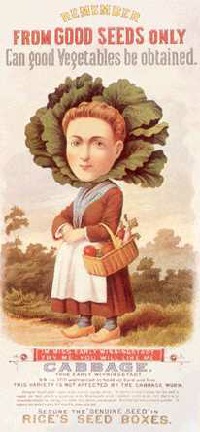 . The hard round head, looks like the pregnant belly...... . The hard round head, looks like the pregnant belly......
It is a strange, earthy way to explain birth.
Money ~ There is an old tradition of increasing your luck with money for the new year by taking a coin and putting it outside on NewYear's Eve. On New Year's day, it is brough inside, a fresh head of cabbage is sliced open so the coin is inserted, the cabbage boiled and then eaten. Tasty--and worth a try! Also, remember--a slang word for money is...CABBAGE!
Luck- The Irish make Colcannon (mashed potatoes and cabbage or sometimes kale. etc,) and often insert a charm--whoever finds it is to have good luck that year.
Slurs ~ A more unsavory use of cabbage lore is as an ethnic slur. Sauerkraut was associated with the Germans, so during WWII, those of German descent were called "KRAUTS".
FOOD ~ OK--so RAW is best--but that doesn't mean you can enjoy a good cabbage roll or soup "Let cabbage soup be entirely cabbage" ~ Nichlolas de Bonnefons (1654). It is more important to eat it regularly, than to always eat it raw. ALL cabbage is good for you! BUT--cutting it makes it lose nutrients quickly, so do not buy shredded or cut cabbage, but them whole and cut before eating ~
Cabbage Rolls- there are two ways to make these--cooked and almost raw. I love cooked ones. Steam the leaves. then fill with a mixture of rice, cheese, sunflower seeds and tomato sauce. Roll them up and Arrange in a casserole dish and bake until cooked through at 350. the healthier way is also a good way to get rid of leftovers quickly: Instead of sreaming and baking, Take a rolling pin to the cabbage leaves until soft, but still sturdy enough. Fill with any type of leftover or combination of beans, mashed potatoes, cheese and chutney, stir fried veggies--you name it--roll it up and eat it!
Salads ~ Why just lettuce? Raw cabbage does not have the strong odor or taste of its cooked counterpart, so it adds a nice bits/crunch to salads. This is how I get my 1 cup per day--split between two salads. Since most salad stuff is green, try red cabbage here or bok choi for the added color, nutrients and health benefits.
Sandwiches ~ Use cabbage instead of lettuce or in addition to it
Soups/ Casseroles ~ Whenever you make these, add some cabbage--not too much-depending on your taste, but it does add a fullness of flavor. Keep your soup lid on and your casserole covered to maintain nutrients.
My Favorite! ~ This recipe was passed to me by my old Apprentice, Deb Thorna, who fed it to the whole class one day years ago--and I have never forgotten it and make it frequently. Slice cabbage, fennel and leeks (in whatever amount combination you like, but for the purpose of this recipe--in descending order). Put in a pot or wok, add some water and cook until done. In a small sauce pan, reduce the juice of two lemons by half over low heat-which will make it strong and sweet. Melt in 2-3 Tblspoons of unsalted butter or more, to taste. Drain veggies, mix with lemon reduction, andadd some lemon zest and 1 cup of chopped parsley. Serve warm or cold--it tastes divine both ways.
Slaw ~ Slaw is a great food--but the mayo makes it a guilty pleasure. Try it with a soy mayonaise instead
Sauerkraut ~ This could not be easier to make: shred FRESH cabbage. For every 5 lbs of cabbage, mix it with 3 Tblsps. of kosher salt. Use a potato masher to pound it into a GLASS or CERAMIC crock, put glass plate directly onto cabbage and weight it down (I use a gallon jug filled with water.) Within several hours, the cabbage will release its own water and be submerged--creating an anaerobic environment. Keep the crock at around 60 degrees for several weeks and keep a piece of cheesecloth over everything to keep out dust. Every few days, skim the scum off. It looks gross, but your submerged kraut is absolutely safe. When the fermentation has made the the kraut taste the way you like it, you can eat it within the next week or so, can it in smaller jars or let it keep going for several months. There can be batch failures (see full directions and fixes in the book "Wild Fermentation" by Katz). This is a food that keeps folks hardy and mellow. It is considered on of the few all around health giving foods.
Why do so many recipes for cabbage contain celery seed or fennel? Both of those help expell gas, but also aid in digestion so so much gas does not form. Using BEANO also works!
The best medicines are eaten--not "taken". Cabbage should become a regular in your diet
GARDENING/HARVESTING/KEEPING ~ Cabbage like a rich soil (though they can be forgiving of poorer soil), sun and water. Until a frost, water is fine, but after, too much rain can cause the heads to split--better to harvest them than to wait for them to grow any bigger. Sun should not be underrated. The biggest cabbages I have ever seen were from Alaska and northern Scotland--where the summer sun is almost constant 20+ hours per day.
The biggest problem with growing cabbage is the cabbage moth/worm and flea beetles. When you see them, spray plants with either of the following: cayenne pepper spray or just sprinkle the powder on--or cayenne in organic liquid soap (I use Dr. Bronners PLAIN Castille ). These have to be re-applied after each rain or heavy dew. THYME is also showing to be a good cabbage moth repellant. I have not used it, but laying spring around and in th ecabbage bed is one way to do it--or making up a spray of thyme tea. For the past several years, I have been saving myself the trouble of spraying and using floating row covers. I put these on as soon as I plant my seedlings. It allows sun/rain to get through--but not bugs. They can be left on all season since these are not flowering plants and so will protect them from other critters like gophers and deer.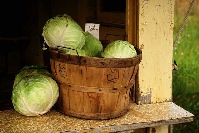
I grow my own plants since I can choose from all the great heirloom varieties. If you prefer certain types of cabbage for certain dishes (savoy makes the best slaw and is easiest for cabbage rolls, bok choi is best for salads/stir fry, red is healthiest) or you find one grows better in your climate or you would like to try a variety your ancestors grew, then seeds are the way to go. The plants can be set out early and are frost hardy--in some areas, you can start a few rotations of cabbages, but in the north, I get one planting. When it is time to harvest, pull them up by the roots and hang them upside down in a root cellar. To eat, cut them off at the root base, remove the outside leaves to check for worms who may be hiding (the outer leaves will also dry out--not to worry, the inner leaves are nice and moist). If buying cabbage, store them in the refrigerator for up to a week or so.
"May the leaves of your cabbage be free of worms". ~ Irish Blessing
Next time you are at the grocery store, take another look at these huge, magnificent vegetables. I agree with Lewis Carroll that cabbages and kings should be mentioned together! Try them, you'll like them!
"Cabbage as a food has problems. It is easy to grow, is a useful source of greenery for much of the year, yet as a vegetable, it has original sin and needs improvement.It can smell foul in the pot, linger through the house with pertinacity and ruin a meal with its wet flab. Cabbage also has a nasty history of being good for you." ~ Jane Grigson
Click here to learn more about cabbage!
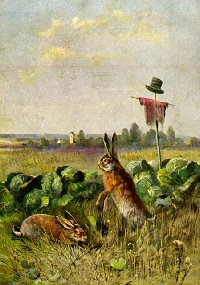
|